The Incarnation Cross in Human Design gives you a deep insight into your life theme. Understanding the Incarnation Cross opens up a deeper level of self-knowledge and allows you to lead your life with greater clarity and direction. In this blog post, I would like to introduce you to the meaning and theory of the Human Design Incarnation Cross. Have fun reading!
To get started: Calculate your Human Design Incarnation Cross
To get started, you can calculate your Incarnation Cross below. Enter your data and you will receive a short description.
This small excerpt from your incarnation cross is just a small teaser of this exciting aspect of your life, which not only gives you a task, but also meaning. As part of a Human Design Reading, I will be happy to treat your incarnation cross in depth.
What is the Human Design Incarnation Cross?
The Human Design Incarnation Cross is made up of the aspects Sun and Earth on the personality side (right conscious side) and the design side (left unconscious side) in the Human Design Chart. These 4 aspects together form the cross, which is also visually recognizable as such in the Human Design Rave Chart (Human Design Mandala) (see picture below).
This cross consists of two oppositions (opposite gates in the mandala) – a conscious and an unconscious opposition. The first conscious opposition arises at the time of birth. The second unconscious opposition arises three months earlier, creating an angle of 88° to the conscious side. Strictly speaking, the cross is not right-angled. It is therefore an inclined cross due to the 88°.
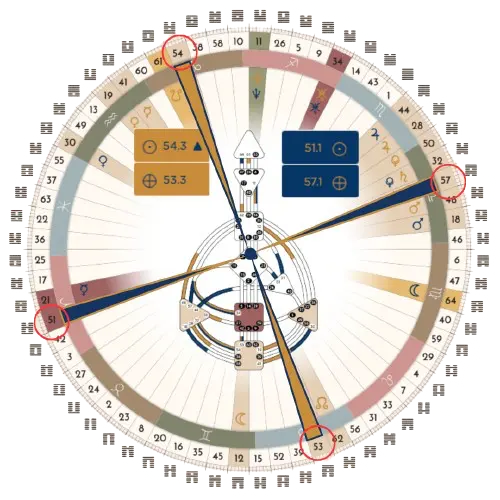
The four gates of the Human Design Incarnation Cross are usually distributed over the four quarters of the Human Design Mandala. These four quarters stand for initiation, edification, community and transformation (see illustration below). The themes of all incarnation crosses are not arbitrarily determined from the outside, but form a common cycle with themes that “logically” follow one another in time. The incarnation crosses therefore not only describe life themes, but also long-term development cycles and sociological processes of humanity.
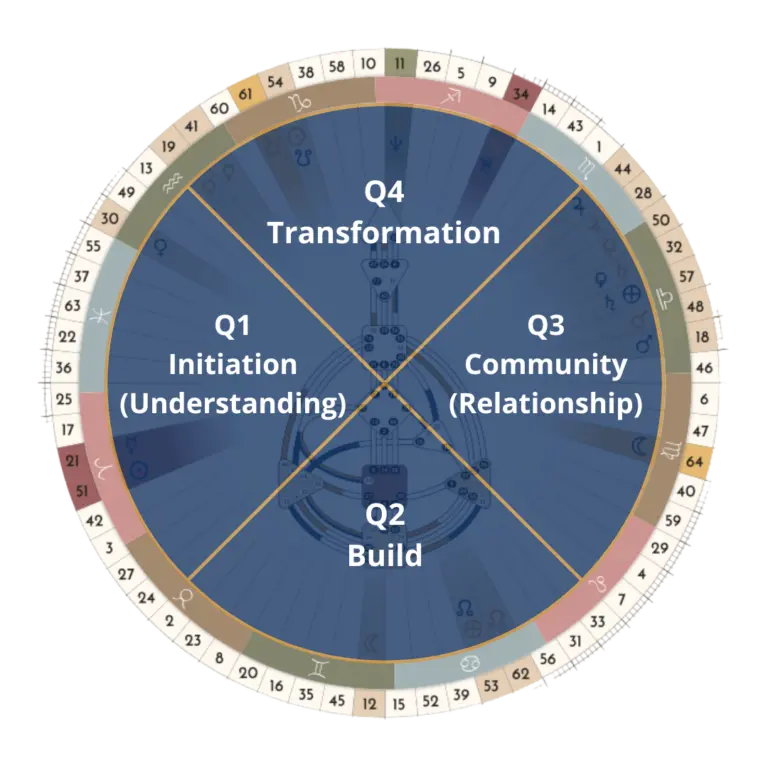
How do I interpret my Human Design Incarnation Cross?
You determine your Incarnation Cross by first determining your Human Design Chart. You can do this here free of charge. In your chart, you now look at the first two planets from above (Sun and Earth) on both sides of the chart.
Sun and Earth on the left represent your unconscious self. This opposition reflects what you are meant to be. The unconscious earth describes how your being is embodied on earth. The unconscious sun describes your charisma, i.e. how others perceive you.
The sun and earth on the right-hand side represent your conscious self. They stand for your mission in life, while the gate of the earth in turn describes how you bring your mission into the world.
Not everything that takes place between the sun and the earth works smoothly and harmoniously in the world, as we see every day. This is probably also the reason for the many different philosophies that try to understand these mysterious tensions. But why is there this friction and discord? One simple explanation is the existence of the tilted wheel, i.e. the 88 degrees that creates the complexity of humanity. At 90°, life on our world would probably be deadly dull.
Definition of terms: life theme, life task and vocation
The terms life theme, life task and vocation are sometimes understood differently. Some experts say, for example, that the conscious sun describes the life task, while the incarnation cross describes the life theme. But from my point of view, the two terms overlap so much that I find it confusing to separate them. That’s why I use both terms as synonyms.
Life theme, life task and vocation
The life theme or life task describes our lifelong development task in this world. The Incarnation Cross in Human Design, which is directly linked to these two terms, is therefore something greater than ‘just’ following one’s own specific talents.
The Incarnation Cross describes the life theme that is given to us from birth. In general, however, it only becomes really relevant in mid-life, because before that we tend to try things out and process them instead of thinking about the life theme. Perhaps it is only at the end of life that we really understand how the life theme has been fulfilled in our lives.
Everyone goes through personal adventures in life, which can also be described as hero’s journeys. A vocation, which we often colloquially associate with an inner call that we can follow, is the first stage of a hero’s journey. The vocations of several hero’s journeys contribute to the life theme like small milestones and give the course of life a common thread. Of course, these callings can also touch on areas of life other than work.
Long cycles next to the Human Design Incarnation Cross
In addition to the Human Design Incarnation Cross, there are exciting cycles on the path of life that can be read from the planetary orbits in the Human Design Mandala. These are shown in the illustration below:
- the first and second orbits of Saturn (1st and 2nd Saturn Return),
- the half orbit of Uranus (Uranus opposition) and
- the orbiting of Chiron (Chiron Return).
These cycles in turn have their own life stage qualities, which must be linked to the characteristics of the incarnation cross.
The Human Design Incarnation Cross in combination with the planetary cycles can be used again and again as an overarching answer to life’s questions of meaning. But as enriching as it is to understand the overarching incarnation cross, the magic of life is to follow the calls of vocations.
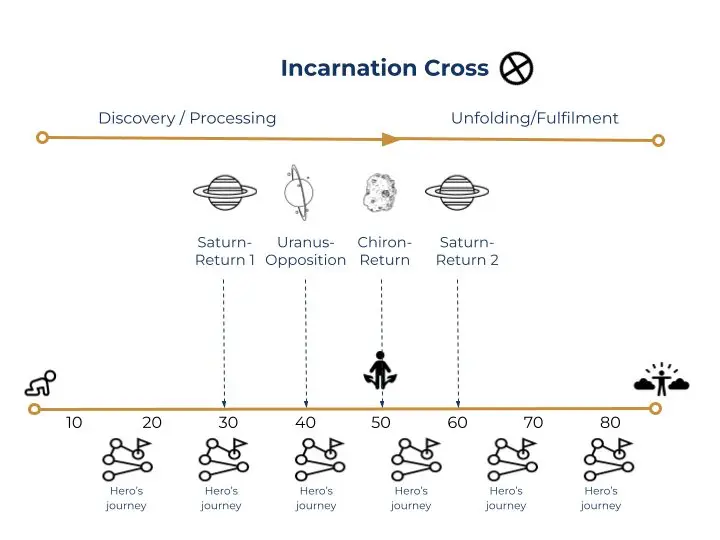
Incarnation cross, cycles and free will
A small philosophical excursion at this point: According to these findings, the question arises as to whether we as humans still have any free will at all if everything is already fixed in incarnation crosses and long cycles. The current planetary weather also has an influence on us and our environment. Although we believe that we make all decisions and actions of our own free will, in reality we are programmed to a certain extent.
That may sound harsh, but it’s not so far-fetched. In my opinion, we should let ourselves drift in this flow and act more reactively than our ego (mind) would sometimes like. The highest wisdom is to give up the struggle and let go without being inactive. We just have to surrender to nature in order to unfold.
The conscious sun with a key role for the Incarnation Cross in Human Design
The Gate of the Conscious Sun and its hexagram line is considered the most influential aspect in the entire Human Design Chart. Its influence in relation to all other planets is estimated at around 70 per cent.
For research nerds: It is assumed that the sun wakes up the junk DNA with its gamma radiation. This is the DNA in us that is known as waste. According to D. Broers*, the sun, together with the cosmic radiation from the interior of our galaxy, sends us new mental abilities by acting on our consciousness. However, it is also assumed that the activated junk DNA leads to increased psychic and mental sensitivity, which could be related to the announced mutation of humans. A harbinger of the so-called rave kids who will see the light of day from 2027?
Back to the Sun: Logically, the conscious Sun also has the greatest influence in the incarnation cross. It acts as a reliable constant, while the other aspects are somewhat more diffuse and only fully unfold in the course of life, especially the unconscious aspects on the design side (left) of the Human Design Chart. It is similar to astrology with zodiac signs and ascendants. The zodiac sign reveals itself quite early in life, whereas the ascendant is often not recognised until mid-life.
It is also interesting to know in which quadrant the conscious Sun is in the Rave Chart (Mandala), as this describes your mission in life (see picture above). If it is in the first quadrant Q1, your life is primarily about understanding and discovery. If your conscious Sun is in Q2, your mission has to do with building or creating (materialising). The Sun in Q3 is very much about relationships and community and in Q4 about transformation.
Facts, figures and data on the Human Design incarnation cross
There are 192 Incarnation Crosses in Human Design. ⅔ of these are personal (the life theme essentially has to do with me personally) and are therefore in the majority. ⅓ are transpersonal (the life theme essentially has to do with me in exchange with others) and fixed in nature (clear path).
Despite the relatively small number of incarnation crosses compared to the number of people in the world, the life themes they contain must be regarded as highly individual, as they manifest themselves differently for each personality. An individualised view of the incarnation cross therefore always requires a special Human Design Reading.
The Incarnation Cross and the Human Design Profiles
In order to understand the Incarnation Crosses, we also have to deal with the 6 lines of the hexagram and thus with the Human Design Profiles. This is because the profiles determine whether we are dealing with a personal (right), transpersonal (left) or fixed cross. The following table shows the connection between profile and destiny (personal/transpersonal/fixed). It also shows the frequency of occurrence.
| Profil | Kreuz | Schicksal | Häufigkeit |
| 1/3 | rechts | persönlich | häufig |
| 1/4 | rechts | persönlich | selten |
| 2/4 | rechts | persönlich | häufig |
| 2/5 | rechts | persönlich | selten |
| 3/5 | rechts | persönlich | häufig |
| 3/6 | rechts | persönlich | selten |
| 4/6 | rechts | persönlich | häufig |
| 4/1 | Juxa | fixiert | sehr selten |
| 5/1 | links | transpersonal | häufig |
| 5/2 | links | transpersonal | selten |
| 6/2 | links | transpersonal | häufig |
| 6/3 | links | transpersonal | selten |
Based on Jansen H.-W., Das Kreuz mit den Kreuzen im Human Design-Mandala (2023), p. 30f.
The table shows that the number of profiles is not evenly distributed (see last column). Without going into too much detail, it is important to know that there are harmonious profiles in which the lines are in the same position in terms of trigrams (two trigrams on top of each other make a hexagram). From this it can be deduced that very few people’s lives are “harmonious” in terms of their life’s work, but rather involve tension. However, a harmonious or disharmonious profile should never be described as good or bad.
Personal (right) incarnation crosses in Human Design
Personal Incarnation Crosses represent a personal life task. These are the crosses with the personal profiles 1/3, 1/4, 2/4, 2/5, 3/5, 3/6 and 4/6. However, personal does not mean that you should have nothing to do with others in this type of incarnation cross. However, you are allowed to spend a lot of time with yourself before you devote yourself to the collective. But then it is certainly about making a contribution to society.
In the following incarnation cross list you will find the 16 themes of the personal incarnation crosses according to Chetan Parkin & Carola Eastwood – The Book of Destinies*:
- The right crosses of the direction (Sphinx)
- The right crosses of the explanation
- The right crosses of transmission (contagion)
- The right crosses of the sleeping phoenix
- The right crosses of planning
- The right crosses of consciousness
- The right crosses of governance
- The right crosses of the Garden of Eden
- The right crosses of the vessel of love
- The right crosses of serving
- The right crosses of tension
- The right crosses of penetration
- The right crosses of the Maya
- The right crosses of the laws
- The right crosses of the unexpected
- The right crosses of the four paths
Transpersonal (left) incarnation crosses in Human Design
The transpersonal incarnation crosses are a supra-personal life task. These are the crosses with the super-personal profiles 5/1, 5/2, 6/2 and 6/3. People on the outside are always needed to fulfill the transpersonal life task. These life tasks often involve being there for others and getting involved. Companions and allies play an important role. Left crosses need right crosses.
In the following incarnation cross list you will find the 32 themes of the transpersonal incarnation crosses according to Chetan Parkin & Carola Eastwood – Book of Destinies*:
- The left crosses of the masks
- The left crosses of the challenge
- The left crosses of the rebellion (revolution)
- The left crosses of devotion
- The left crosses of diligence
- The left crosses of uncertainty
- The left crosses of the Spirit
- The left crosses of duality
- The left crosses of moving on
- The left crosses of identification
- The left crosses of the dominion
- The left crosses of separation
- The left crosses of sharing
- The left crosses of confrontation
- The left crosses of the (earthly) plane
- The left crosses of education
- The left crosses of healing
- The left crosses of prevention
- The left-wing crosses of upheaval
- The left crosses of the demands
- The left crosses of effort
- The left crosses of individualism
- The left crosses of the fanfare
- The left crosses of the cycles
- The left crosses of the boundary
- The left crosses of concealment
- The left crosses of wishes
- The left crosses of distraction
- The left-hand crosses of the alignment
- The left crosses of the Alpha
- The left crosses of the incarnation
- The left crosses of refinement
Fixed (Juxaposition) Incarnation Crosses in Human Design
The fixed Incarnation Crosses are a fixed life task and an activation of the 4/1 profile (juxtaposition). These crosses are about bringing your own fixed life task or life message into the world; the fixed life theme stands between the personal and transpersonal crosses and therefore has its own fixed life path under the observation of the other crosses.
The Incarnation Cross list of fixed Incarnation Crosses amounts to 64 different designations. Due to the large number, I have refrained from listing them.
The influence of the Incarnation Cross on professional development
In my Human Design Readings, I like to consult the Incarnation Cross when I look at professional life from a high altitude (meta-level) with my clients. Whether I work on the Incarnation Cross in depth with my clients depends very much on their age. Especially when my clients have passed the age of 40, it makes a lot of sense to look at the Human Design Incarnation Cross.
In this context, I like to combine the Incarnation Cross with the information from the current life cycle, such as the Uranus opposition, which can be associated with the midlife crisis, or the Chiron Return, which makes the person’s wisdom visible. I like to use the gates of the south and north lunar nodes to make the direction in life even more transparent. The Incarnation Cross and the planetary life cycles can reveal exciting information for professional development. An incarnation cross reading with these combinations is very interesting and helps you to understand yourself.
3 tips for your life theme
1. Consider the Human Design Centers of the Gates in the Incarnation Cross
To view your life theme from a meta-level, you can look at the properties of the Human Design Centers where the gates are located in the Human Design Chart. This will give you a first impression of which themes have a major influence on your life.
2. Do not approach your life issue with impatience
Until the age of 30, it’s about discovering your individuality, e.g. by testing yourself to recognize your strengths and talents. After that, it is about processing what you have experienced in order to develop your mastery later on. The development of your mastery is directly related to your life’s work. This is why it makes sense to focus more intensively on your life’s work from the age of 50. So don’t be impatient at an early age. The theme of life will call when the time is right.
3. Carry your Incarnation Cross with responsibility
The life theme is about bringing something into the world that will help you and benefit others. Even if the connections between self-interest and giving are not always clear, you can sense from your good emotions that you are on the right path. Because emotions are the bridge between your incarnation and your higher mission.
Conclusion
The Incarnation Cross in Human Design not only reveals deep insights into our individual life theme, but also serves as a powerful guide on our personal and professional journey. By observing the four central gates, it enables us to recognize our true calling and to follow it courageously.
One aspect that should not be neglected in connection with life’s purpose is the meaning of life. For people who do not find their purpose in life, the risk of that “I wish I had…” feeling increases with age. And perhaps even diseases such as dementia or Alzheimer’s. But I’m not a doctor, I just read lots and lots of books.
The Human Design Incarnation Cross is therefore a signpost that encourages us to follow our inner calling, remain true to ourselves and develop our full potential. Let us walk this path with openness, dedication and love in order to make the best of ourselves and the world.
Have you already dealt with your Incarnation Cross? What are your insights? What are your questions? Feel free to write them in the comments below.
FAQ: Questions about the Incarnation Cross – Human Design
What is the Incarnation Cross in Human Design?
The Human Design Incarnation Cross represents the overarching life theme based on the position of the sun and earth at the time of your birth and three months before.
When does the Incarnation Cross play a greater role in life?
The Incarnation Cross in Human Design plays a decisive role in the second half of life. It becomes particularly relevant from the age of 40, when the search for deeper meaning and fulfillment in life increases.
Are there different types of Incarnation Crosses in Human Design?
Yes, there are 192 different incarnation crosses, divided into three categories: personal (right), transpersonal (left) and fixed (juxtaposition). You can find many of them in the incarnation cross list above. Each cross has a unique meaning and shows different life paths and themes.
How can knowledge of the Human Design Incarnation Cross influence personal and professional development?
Understanding your Incarnation Cross helps you to better recognize and use your own strengths and weaknesses. It promotes deeper self-acceptance and self-realization in your private and professional life.
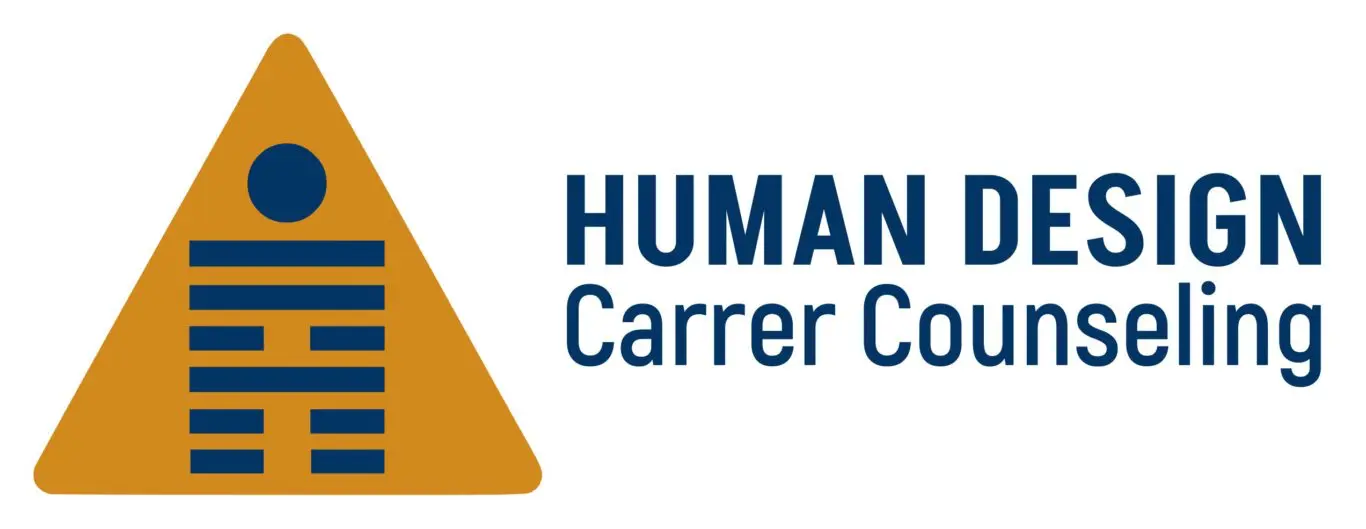

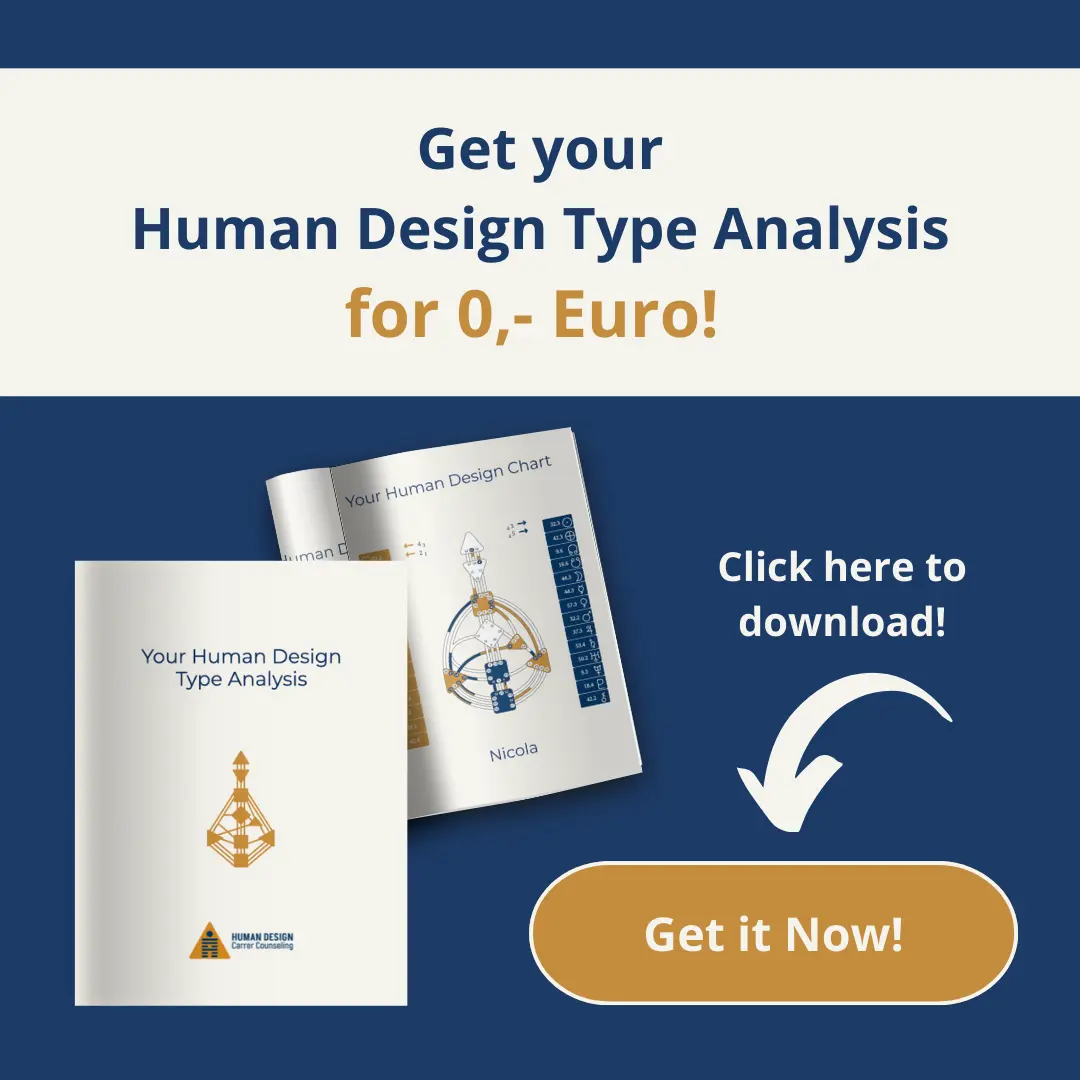


0 Comments